- News
- Reviews
- Bikes
- Accessories
- Accessories - misc
- Computer mounts
- Bags
- Bar ends
- Bike bags & cases
- Bottle cages
- Bottles
- Cameras
- Car racks
- Child seats
- Computers
- Glasses
- GPS units
- Helmets
- Lights - front
- Lights - rear
- Lights - sets
- Locks
- Mirrors
- Mudguards
- Racks
- Pumps & CO2 inflators
- Puncture kits
- Reflectives
- Smart watches
- Stands and racks
- Trailers
- Clothing
- Components
- Bar tape & grips
- Bottom brackets
- Brake & gear cables
- Brake & STI levers
- Brake pads & spares
- Brakes
- Cassettes & freewheels
- Chains
- Chainsets & chainrings
- Derailleurs - front
- Derailleurs - rear
- Forks
- Gear levers & shifters
- Groupsets
- Handlebars & extensions
- Headsets
- Hubs
- Inner tubes
- Pedals
- Quick releases & skewers
- Saddles
- Seatposts
- Stems
- Wheels
- Tyres
- Health, fitness and nutrition
- Tools and workshop
- Miscellaneous
- Cross country mountain bikes
- Tubeless valves
- Buyers Guides
- Features
- Forum
- Recommends
- Podcast
review
£1,249.00
VERDICT:
Canyon kicks a goal with its first cyclo-cross bike, a good example of a modern, versatile disc-braked crosser
Weight:
9,320g
Contact:
www.canyon.com
At road.cc every product is thoroughly tested for as long as it takes to get a proper insight into how well it works. Our reviewers are experienced cyclists that we trust to be objective. While we strive to ensure that opinions expressed are backed up by facts, reviews are by their nature an informed opinion, not a definitive verdict. We don't intentionally try to break anything (except locks) but we do try to look for weak points in any design. The overall score is not just an average of the other scores: it reflects both a product's function and value – with value determined by how a product compares with items of similar spec, quality, and price.
What the road.cc scores meanGood scores are more common than bad, because fortunately good products are more common than bad.
- Exceptional
- Excellent
- Very Good
- Good
- Quite good
- Average
- Not so good
- Poor
- Bad
- Appalling
Versatile disc-equipped cyclocross bike perfect for fun in the woods or racing.
Canyon's new Inflite AL 8.0 is the German company's first ever cyclo-cross bike. We first spotted it at Eurobike a few months ago where it was turning a few heads, and now I've spent some time riding it I can say the head turning was fully justified: it's a fast and fun bike suitable for playing in the woods or going racing at the weekends.

As is usual with Canyon's direct-to-customer sales approach, it's a cracking price. This £1,249 model, one of three available, packs a Shimano 105 groupset with cyclocross-specific 46/36 chainset and Shimano BR-CX77 mechanical disc brakes, replacements for the CX75 brake which was recalled this summer, as a result our test bike came with TRP Spyre mechanical discs. Everything else is the same as the production bikes.
Ride: Solid and stable with easy handling
Jump aboard the Inflite (cyclocross-style of course) and the bike instantly feels just right. The size large has a good reach with plenty of space for maneuvering through the trees and the necessary shapes you throw in the process.
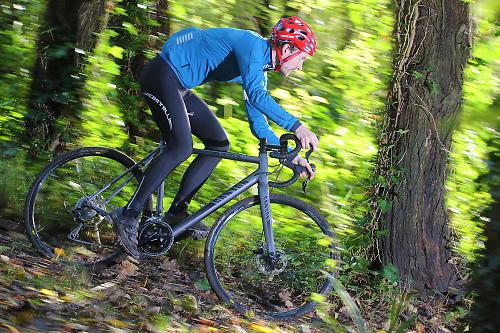
The geometry is a touch more relaxed than a road bike - 72 degree head angle - and provides steering that is a little bit slower on the road, but on the trail it manifests itself as stable handling. The head tube measures 16cm on this size large, a bit shorter than the equivalent Ultimate AL road bike so you get a good low position. The 56.3cm effective top tube is a smidgen shorter too. The stability I mentioned comes from the longer wheelbase, 1025mm compared to 995mm of the same size Ultimate AL road bike. This immediately ensures you feel right at home and comfortable on the Inflite, it's not at all nervous or twitchy.
The frame is certainly stiff enough for demanding cyclocross riding. The oversized down tube, tapered head tube and chunky chainstays give good responses when powering out of slow corners. The full carbon fork ensures the front end feels solid, and also gives a precision to the handling, allowing you to place the front wheel accurately where you want it. As a result it flies through corners and holds tight arcs around trees with fantastic poise.
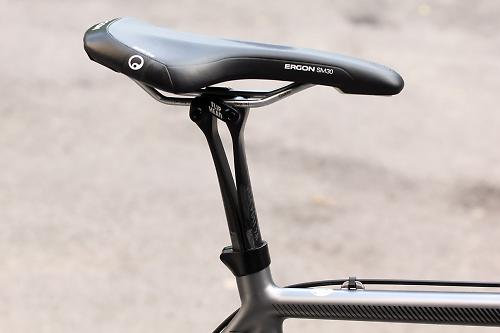
Mud clearance is vital for a cyclocross bike, and the Inflite has loads of it. There's plenty of space around the tyres at the fork, and by omitting the chainstay bridge in the rear triangle there's more than enough space for mud to drop through.
At 9.32kg (20.54lb) it is a touch on the heavy side. This might concern racers who want a sub-20lb race bike, but away from the confines of racing the weight becomes of less concern. It doesn't feel heavy to ride though, and certainly it's the lightest disc-equipped cyclo-cross bike road.cc has tested. Instead the weight gives the Inflite good ballast for blasting down all manner of trails, from the rocky eye-watering track linking Dartmoor's Princetown to Burrator reservoir. It also means it doesn't feel too flighty, and that will suit beginners and cyclocross novices well.

It was actually riding that trail that highlighted just how capable the Inflite is. As happy as it is to race, it's more than capable of taking on bigger challenges than an hour spent racing around a muddy playing field. On this long-distance ride the Inflite proved the perfect accompaniments, happily a range of surfaces from tackling the rougher trails littered with boulders and rock to stretches of public highway. Ride along the road, dive off onto a bridleway, pop back out onto the road, and repeat.
With a wealth of cyclo-cross sportives and off-road events to take part in, plus of course DIY challenges starting with an OS map and plotting your own adventure, we've seen a rise in disc-equipped cyclocross bikes (pretty much since the UCI ratified them for pro level use) but while the pros might not be clamouring for discs, there is a growing number of non-racers who are realising such a bike is ideal for the riding they day.
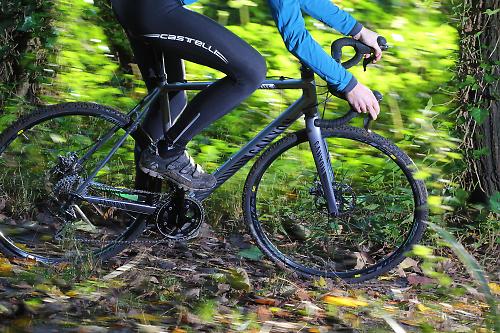
Versatility is a big part of the attraction and your imagination is the only limit. The frame even has concealed mudguard eyelets, so you could fit 'guards and slicks and use it as a pure road bike during the week (a fact highlighted by the Inflite AL 9.0 S which comes with slicks and mudguards), and ride it off-road at the weekend. With two sets of wheels the Inflite could happily be the last one bike to do-everything.
Frame: Stiff and strong alloy frame with smart details

Canyon produce really nice alloy road bikes, and they've transferred that expertise well in their first cyclocross bike. The frame is oversized in the down tube with a bit of gentle profiling along its length, and houses the internally routed gear cables. The top tube has a square shape where it meets the seat tube, to give a flat underside surface for shouldering. The rear brake cable is kept out of the way, routed along the top of the top tube.
The Maximus seat tube is borrowed directly from the Ultimate AL road bike, and there's the same press-fit bottom bracket as well. This ensures the bottom bracket zone is hugely stiff - you certainly notice it when pedalling hard, there's no discernable deflection or twist no matter how angrily you stand on the pedals.
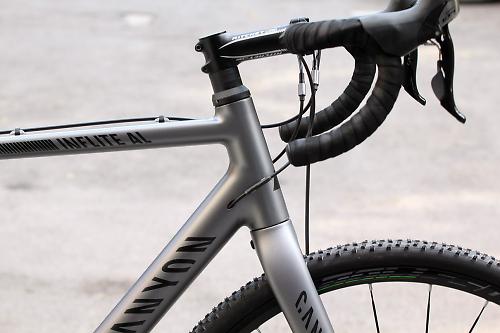
Up front is a tapered head tube with a new One One Four SL Disc carbon fibre fork plugged into place, held in the frame by Canyon's novel i-Lock headset. Instead of preloading the headset bearings with a conventional star fangled nut or expander wedge, you tighten the stem onto the steerer and remove play with a tiny Torx bolt in the top headset spacer. The fork, like the 135mm spaced dropouts, uses regular quick release axles.
Out back Canyon also employ similar VCLS (Vertical Comfort, Lateral Stiffness) stays to those found on their road bikes. They are asymmetrical, to counter the twisting forces from the pedalling and braking loads, yet Canyon claim the seatstays offer improved comfort. The idea is to provide a bit of vertical deflection to kill some of the vibration and buzz.
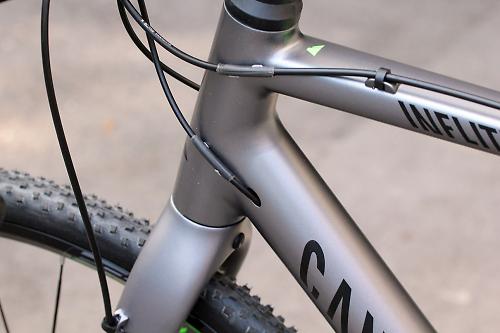
Canyon claim a frame weight of 1,480g (3.26lb).
Build kit: Disc brakes and unique buzz-killing carbon post
You get an impressive build kit on the Inflite. First up is the unique seatpost, the VCLS Post 2.0. Made from carbon fibre, the post is essentially a flat spring, comprising two sections bolted together at either end, and designed to flex. And by jingo it really works. It's most noticeable on bigger impacts, and there are plenty of those riding offroad - rocks, roots and other obstacles - but is also noticeable on smaller stuff. It's a bit more fiddly to set up (you have to remove the post from the frame, undo the bottom bolt, put it back in, set the saddle angle, then remove the post again and tighten the bolt).
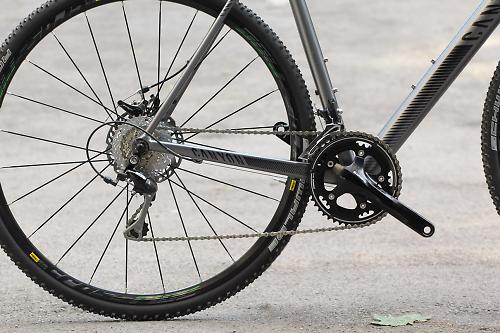
The Shimano 105 transmission might not win any weight weenie awards, but it works brilliantly, with reliable shifting works even when the cassette is caked in mud. The CX50 chainset is a cyclocross-specific 46/36, and paired with the 11-32 cassette gives a huge range of gears, especially at the low end. Which is good, you generally need much lower gears riding off-road. On the Kinesis Hell of the West down on Dartmoor I was able to get up the steepest hills without too much bother. Lots of sweaty and searing leg pain yes, but no lack of gear ratios. On the road that clearly limits the top speed, but I could happily blast along at 20mph.
As I mentioned earlier, production bikes will come with Shimano BR-CX77 mechanical disc brakes, so there's little point in talking too much about the TRP's Spyre brakes my test bike was fitted with. But I will a little anyway.
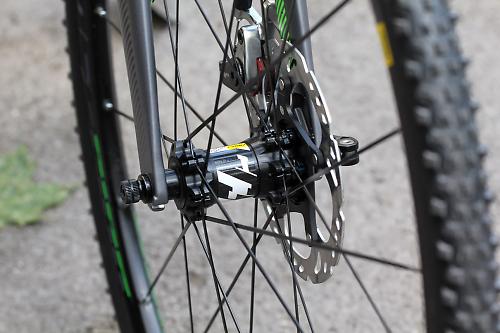
Paired with 160mm rotors at both wheels the brakes, once they had bedded in (doesn't take long riding through streams and muddy fields) provided very reliable and consistent braking. Taking the braking away from the edge of the wheel and placing it at the centre is a huge benefit when riding through deep mud, it means the brakes are much less affected. This means they keep on working, they're also much quieter, even when you do get mud splashed onto the rotor. Neither did they require any maintenance of any sort, they just kept working as they did from new.
I found the brakes lacked in power in bite compared to hydraulics though, but they were marginally more powerful than really well set-up cantilevers. However, the biggest benefit is that they keep on working, providing predictable braking without the usual degradation in bad conditions of cantis, no matter how messy the trail or conditions. On a couple of steep and fast road descents I found them much more reassuring. Being able to stop safely shouldn't be overlooked. Lastly, there was non of the horrible brake judder that blights just about every canti-equipped cyclocross bike I've even ridden.
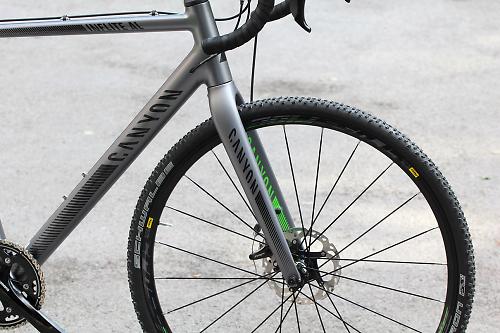
The Mavic Crossride 29 wheels are basically mountain bike 29er wheels. Why mountain bike wheels? There is still a limited choice of road disc wheels, that will change in time, but for now a mountain bike wheelset is a smart move. There is no shortage of strength or stiffness, they're absolutely solid and bombproof. They're a bit portly at a claimed 2,020g weight for the pair, and would be a prime upgrade if you wanted to shed a bit of that weight, especially if you were looking at the Inflite for racing.
Wrapping the wheels are Schwalbe Racing Ralph Evo tyres. In 33mm width (UCI legal, but of little consequence to any potential customers of the bike I imagine) and with a square block tread pattern they provide good traction in a range of conditions, and a good sized volume for soaking up impacts and bumps. They're fast rolling too, but they're best suited to dry and hard pack trails, show them a muddy bridleway and they will soon clog up and start spinning.
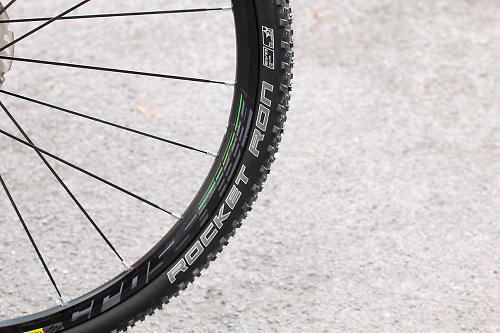
The tyres come fitted with lightweight inner tubes, fine for racing but for general purpose riding I would recommend fitting some tougher inner tubes, or even better some Slime or similar tubes. The tyres don't have a very thick sidewalls and at even pressures of 50 psi it's a bit too easy to pinch the tube on rocks.
Finally, no complaints from the Ritchey WCS 4-Axis stem or WCS Evo Curve handlebar, both a good length and nice shape respectively. I didn't expect the flat Ergon SM30 saddle to be comfortable at all, but just goes to show you shouldn't base an opinion on looks alone: it turned out to be a thoroughly comfortable saddle.
Conclusion
For racing and riding around the woods, the Inflite is a cracking example of the modern disc-equipped cyclocross breed. The aluminium frame, carbon fork, geometry and the disc brakes are winning formula. Chuck in concealed mudguard mounts and it could happily do service as a slick-tyred mudguard-equipped winter road bike.
Verdict
Canyon kicks a goal with its first cyclo-cross bike, a good example of a modern, versatile disc-braked crosser.
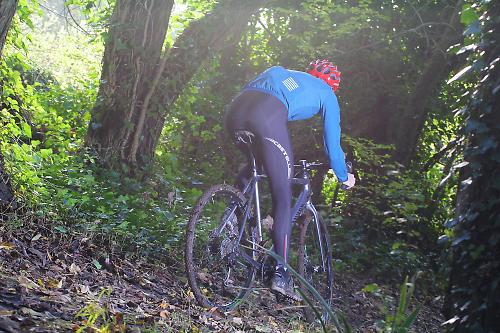
road.cc test report
Make and model: Canyon Inflite AL 8.0
Size tested: large
About the bike
State the frame and fork material and method of construction. List the components used to build up the bike.
Shimano's tried and tested 105 groupset and the robust Mavic Crossride 29er broad rim wheels stand for optimum performance even under the toughest conditions. Whatever the weather, the strong 160 mm disc brakes ensure a faultless braking performance. Whether cross country racing or winter training, the Inflite AL always gives you an enjoyable ride.
Tell us what the bike is for, and who it's aimed at. What do the manufacturers say about it? How does that compare to your own feelings about the bike?
Fast, strong, highly manoeuvrable and with great staying power – the new Inflite AL is tuned to the rough conditions of cyclocross, down to the last detail. Thanks to its optimum pedal hub height and rigid carbon fork, it can take tight bends in its stride, while the pressfit bottom bracket and Maximus Seattube give maximum braking and acceleration performance – the genes of the successful Ultimate AL are unmistakable.
Frame and fork
Overall rating for frame and fork
8/10
Tell us about the build quality and finish of the frame and fork?
Solid construction, smooth welds and neat finishing touches.
Tell us about the geometry of the frame and fork?
More relaxed with a shorter head tube and longer wheelbase than a similarly sized road bike, gives relaxed and stable handling.
Riding the bike
Was the bike comfortable to ride? Tell us how you felt about the ride quality.
The frame dampens a surprising amount of road and trail buzz, even with slick tyres replacing the large volume knobblies. The VCLS 2.0 seatpost does a wonderful job of taming the bigger impacts.
Did the bike feel stiff in the right places? Did any part of the bike feel too stiff or too flexible?
Very stiff when standing on the pedals.
How did the bike transfer power? Did it feel efficient?
Extremely so.
Tell us some more about the handling. How did the bike feel overall? Did it do particular things well or badly?
The handling was very relaxed and stable off the road and on the trails with good agility through fast and twisty sections.
Rate the bike for efficiency of power transfer:
8/10
Rate the bike for acceleration:
7/10
Rate the bike for sprinting:
7/10
Rate the bike for high speed stability:
8/10
Rate the bike for cruising speed stability:
7/10
Rate the bike for low speed stability:
7/10
Rate the bike for flat cornering:
7/10
Rate the bike for cornering on descents:
8/10
Rate the bike for climbing:
7/10
The drivetrain
Rate the drivetrain for performance:
8/10
Rate the drivetrain for durability:
8/10
Rate the drivetrain for weight:
7/10
Rate the drivetrain for value:
8/10
Wheels and tyres
Rate the wheels and tyres for performance:
7/10
The Mavic wheels are a bit portly.
Rate the wheels and tyres for durability:
7/10
I would recommend swapping the tyres for more robust tyres for anything but 'cross racing.
Rate the wheels and tyres for weight:
7/10
Rate the wheels and tyres for comfort:
7/10
Rate the wheels and tyres for value:
7/10
Tell us some more about the wheels and tyres.Did they work well in the conditions you encountered? Would you change the wheels or tyres? If so, what for?
I would certainly change the inner tubes, and unless I was only racing, I would change to more robust tyres. The tyres also weren't much cop in the mud, they don't clear very well and clog up badly.
Controls
Rate the controls for performance:
8/10
Rate the controls for durability:
8/10
Rate the controls for weight:
7/10
Rate the controls for comfort:
7/10
Rate the controls for value:
7/10
Your summary
Did you enjoy riding the bike? Had a lot of fun, and smiled much, riding this bike.
Would you consider buying the bike? If I had the funds, maybe - but I'd want to swap to lighter wheels and better tyres.
Would you recommend the bike to a friend? Yes.
Rate the bike overall for performance:
8/10
Rate the bike overall for value:
8/10
About the tester
Age: 31 Height: 180 Weight: 67
I usually ride: My best bike is:
I've been riding for: 10-20 years I ride: Every day I would class myself as: Expert
I regularly do the following types of riding: road racing, time trialling, cyclo cross, commuting, touring, mtb,
David worked on the road.cc tech team from 2012-2020. Previously he was editor of Bikemagic.com and before that staff writer at RCUK. He's a seasoned cyclist of all disciplines, from road to mountain biking, touring to cyclo-cross, he only wishes he had time to ride them all. He's mildly competitive, though he'll never admit it, and is a frequent road racer but is too lazy to do really well. He currently resides in the Cotswolds, and you can now find him over on his own YouTube channel David Arthur - Just Ride Bikes.
Latest Comments
- No Reply 32 min ago
A bit of a waste of time when most people cannot or will not pay to watch cycling on TNT. How are these young cyclists going to be inspired?
- muhasib 1 hour 30 min ago
So it's cheaper to pay monthly at £4.99 rather than once at £59.99?
- grumpyoldcyclist 1 hour 43 min ago
- because in fact cyclists have been prosecuted and convicted as above, so really he's talking nonsense (or at least needs to present some...
- Bigtwin 1 hour 45 min ago
I for one like your contribution. I mean, it's good to know that Tory ex-Home Secretaries are busy spewing bile into their keyboards at home, not...
- Bigtwin 2 hours 12 min ago
A smidge of £8.5K. Seriously. Someone needs to have a strong coffee.
- Bigtwin 2 hours 16 min ago
Business model innit? When they brought in hire bikes in our town, they approached the bike shop I was then running to so the maintence. It was...
- IanEdward 2 hours 23 min ago
Nice, tyre clearance AND 2x AND non-boring paint jobs, a good alternative to Giant Revolt/ Canyon Grizl....
- Hirsute 2 hours 29 min ago
For the first time, the Norwegian government has calculated the value to society of the health benefits of increased walking and cycling. ...
- graybags 2 hours 36 min ago
I managed to do 12 200k's over 12 months , but unfortunately didn't read the rulles, two were in the same month and I missed a month..................
- nodgedave 2 hours 41 min ago
Toddle off cynic. A great man posting about extremely awful things and you chose to say that? The UCI needs clinical experts like you ... toddle...



































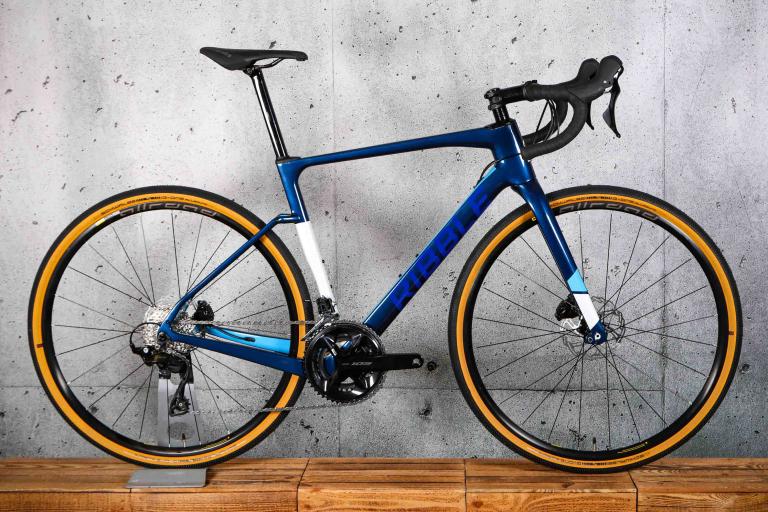
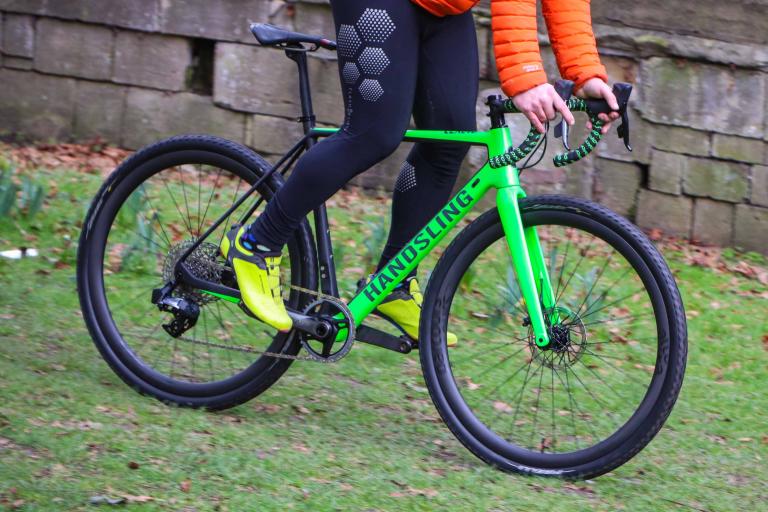

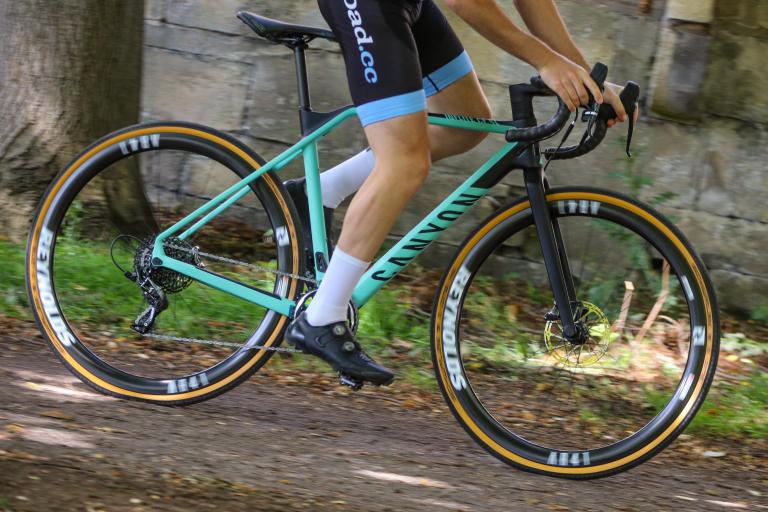
Add new comment
13 comments
Yay!
So, after a lot of discussion we've decided that an 8 is a truer reflection of how good the Canyon is particularly in relation to the other cyclo-cross bikes we've tested. The Inflite is a lot of bike for the money, and as a whole the weight is competitive compared to other disc and canti-equipped CX bikes road.cc has tested recently.
Normally all this is sorted out before the review is published, but that's what happens when you put reviews up on a Sunday.
MMM, not overly impressed with the Canyon CX. Ridley Brand Cyclo Cross Bikes will take some beating for looks reliability and lightness; as for performance, well Ridley are number one for CX bikes.
£12.50 for the Canyon CX isn't a good price; it's expensive.
Care to highlight some examples?
The Canyon is a good price comsidering you get a full 105 group set, Royce bars and stem, full Mavic wheel set and the Canyon seat pin is over £200 to buy on its own. Most other makes ranging from £900 to £1200 use naff manufacters own finishing kit, mixed group sets parts such 105 mixed with tiagra and FSA chainsets and wheels often built with unbranded hubs. At least with Mavic wheels you get a great warranty and service via your local Mavic dealer.
I'm also a little confused by the score - this reads like a rave review. Worth 4 stars, surely?
Don't get me wrong but what made you give just 3,5 stars in this review? The bike is indeed a bit heavy but still the review is quite positive IMHO. Isn't this rating a bit too rough?
Still a great review though!
Was wondering that myself. Wheels and tyres not good enough?
It's a shame about the bespoke mudguards (on the commuter one). They don't look all that stiff to me (on the rear).
Great looks as usual, great spec. Though perhaps not as far ahead on specs and cost as their road and MTB range.
For me I think I might be inclined to plump for a Kinesis Crosslight Pro6 in lime green. Available now, slightly cheaper, on spec.
I recoken with a bit of cutting and fettling you could get a set of stand mudguards to fit. If you want stiff set of mudguards try Portland Design Works full metal fenders. Very stiff and look fantastic. Regarding running dics brakes on the road for commuting is that discs don't like road film and the relatively light use on road. I ride a Giant Seek with hydraulic discs on my short ride to work and they squeel like a pig in not time. Discs need some mud to scrub them clean or lots of regular cleaning if you only using on the road. I have the brakes serviced and new pads fitted three time in about 2500 to 3000 miles.
Much as I like the look of the Kinesis, it's actually slightly more expensive at £1399 and isn't available - in my size at least (60cm) - for 'a few months' according to my LBS.
Looks like a good replacement for my aging specialised cyclocross comp which I've never been very happy with.
For the brakes, Shimano CX77's weren't recalled, they were the replacement model, it was the CX75's that were subject to the recall.